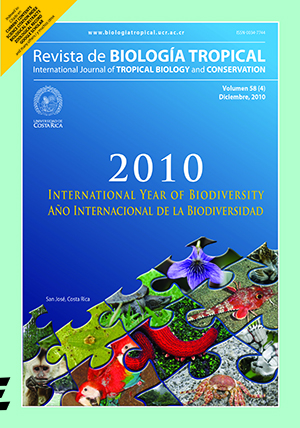Abstract
Generally, natural environments have been transformed into small forest remnants, with the consequent habitat loss and species extinction. The North ParanáState is not an exception, since only 2 to 4% of the original ecosystem occurs in small fragments of Stational Semidecidual Forest. We studied the species richness and abundance of bats in two forest fragments from the Fazenda Congonhas, in Rancho Alegre city, Paraná State, Brazil. Four samplings were undertaken in a legally protected native area (107.8ha) and in a reforested area (11.8ha) between April 2007 and March 2008. Samplings began at nightfall and lasted six hours, during two consecutive nights in each location. The individuals were captured using eight mist nets, with the same capture effort in both environments. A total of 397 individuals, 14 species and 10 genera were captured in the native area; while in the reforested area, 105 individuals, six species and four genera. Artibeus lituratus was the most common species in both fragments (n=328, 65.3%), followed by Artibeus fimbriatus (n=44, 8.8%) and Artibeus jamaicensis (n=30, 6.0%). Other species including Platyrrhinus lineatus, Carollia perspicillata, Sturnira lilium, Chrotopterus auritus, Desmodus rotundus, Michronycteris megalotis, Phyllostomus hastatus, Phyllostomus discolor, Myoti levis, Myotis nigricans and Lasiurus blossevillii, accounted for 19.9% of the captures. The native area presented higher values of species richness (S=14) and diversity (H'=1.4802) in comparison to the reforested area (S=6, H'0.57015). The t-test evidenced a significant difference between diversity among the sites (t=7.1075). Chao 1 index indicated that the sampling effort recorded approximately 78% from the total species richness for the native area and 75% for the reforested area. Therefore, the preservation of the forest fragment is essential since it provides habitat for a diverse community of bats. Forest management and reforestation actions may prevent drastic changes in the microclimate of neighboring areas within the forest fragment, and could allow the occupation of available niches in the area, by opportunistic and generalist species.##plugins.facebook.comentarios##

This work is licensed under a Creative Commons Attribution 4.0 International License.
Copyright (c) 2010 Revista de Biología Tropical
Downloads
Download data is not yet available.






